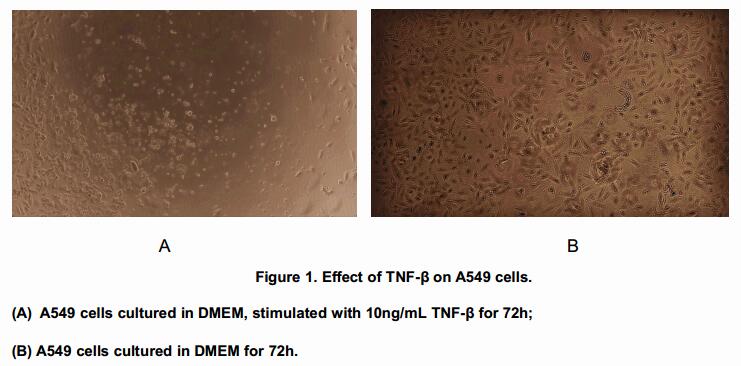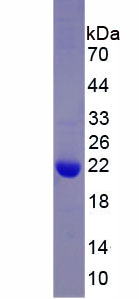Active Tumor Necrosis Factor Beta (TNFb) 

LT; LTA; TNF-B; TNFSF1; Tumor Necrosis Factor Ligand Superfamily Member 1; Lymphotoxin Alpha
- UOM
- FOB US$ 301.00 US$ 752.00 US$ 1,504.00 US$ 4,512.00 US$ 11,280.00
- Quantity
Overview
Properties
- Product No.APA134Hu01
- Organism SpeciesHomo sapiens (Human) Same name, Different species.
- ApplicationsCell culture; Activity Assays.
Research use only - DownloadInstruction Manual
- CategoryCytokineTumor immunityInfection immunity
- Buffer FormulationPBS, pH7.4, containing 0.01% SKL, 5% Trehalose.
- Traits Freeze-dried powder, Purity > 97%
- Isoelectric Point9.3
Sign into your account
Share a new citation as an author
Upload your experimental result
Review

Contact us
Please fill in the blank.
Activity test

TNF-β, a member of the tumor necrosis factor family, is a potent lymphoid factor that exerts cytotoxic effects on a wide range of tumor cells. The biological effects of TNF-β are very similar to TNF-α, due to the similarity of molecular structure and the receptors. As reported, TNF-β could inhibit the proliferation and induce necrosis of A549 cells, and the concentration of IL-1β in cell supernatant will increase after stimulation. Therefore, A549 cells were incubated in DMEM with TNF-β (10ng/mL) for 8h, 24h, 48h, 72h, then cells were observed by inverted microscope and IL-1β was detected in the cell supernatant by ELISA .
Cell necrosis after incubation with TNF-β(10ng/mL) for 72h was shown in Figure 1.

The production of IL-1β after incubation with TNF-β (10ng/mL) for 8h is shown in Table 1.
Usage
Reconstitute in 10mM PBS (pH7.4) to a concentration of 0.1-1.0 mg/mL. Do not vortex.
Storage
Avoid repeated freeze/thaw cycles. Store at 2-8°C for one month. Aliquot and store at -80°C for 12 months.
Stability
The thermal stability is described by the loss rate. The loss rate was determined by accelerated thermal degradation test, that is, incubate the protein at 37°C for 48h, and no obvious degradation and precipitation were observed. The loss rate is less than 5% within the expiration date under appropriate storage condition.
Increment services
-
 BCA Protein Quantification Kit
BCA Protein Quantification Kit
-
 Molecular Mass Marker for Protein
Molecular Mass Marker for Protein
-
 Monoclonal Antibody Customized Service
Monoclonal Antibody Customized Service
-
 Polyclonal Antibody Customized Service
Polyclonal Antibody Customized Service
-
 Protein Activity Test Experiment Service
Protein Activity Test Experiment Service
-
 Electrophoretic Mobility Shift Assay (EMSA) Experiment Service
Electrophoretic Mobility Shift Assay (EMSA) Experiment Service
-
 Buffer
Buffer
-
 Lentivirus Packaging Experiment Service
Lentivirus Packaging Experiment Service
-
 Adenovirus Packaging Experiment Service
Adenovirus Packaging Experiment Service
-
 Real Time PCR Experimental Service
Real Time PCR Experimental Service
-
 Spike RBD Protein (S-RBD)
Spike RBD Protein (S-RBD)
-
 Protein G
Protein G
-
 Protein A
Protein A
Citations
- Simvastatin attenuates sympathetic hyperinnervation to prevent atrial fibrillation during the postmyocardial infarction remodeling processPubMed: 22984252
- Effectiveness of pure argon for renal transplant preservation in a preclinical pig model of heterotopic autotransplantationPubmed:26847569
- Protective Role of Bone Marrow Derived Mesenchymal Stem Cells-Conditioned Medium in the Infarcted Myocardium: The Potential Role of Selected CytokinesIJST-2328-3548-04-803
- Effect of Multi-Microbial Probiotic Formulation Bokashi on Pro-and Anti-Inflammatory Cytokines Profile in the Serum, Colostrum and Milk of Sows, and in a …Pubmed:29305686
- Fasciola gigantica excretory-secretory products (FgESPs) modulate the differentiation and immune functions of buffalo dendritic cells through a mechanism …Pubmed: 32680553
- Microbiome changes in patients with chronic heart failure with preserved ejection fraction correlate with fibrosis markers: Description of a Russian cohort
- Elevated lymphotoxin-¦Á (TNF¦Â) is associated with intervertebral disc degeneration33441130








